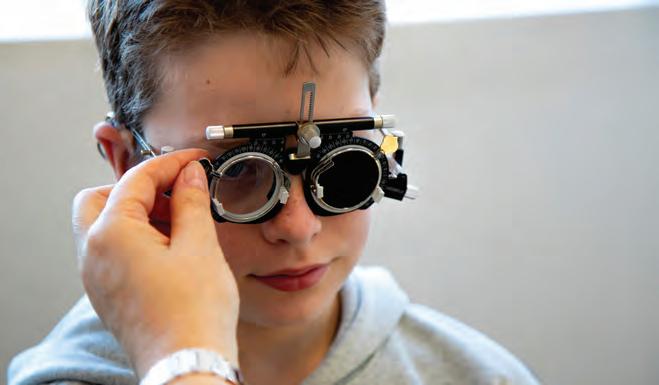
8 minute read
UPFRONT
from Insight April 2021
by Prime Group
Just as Insight went to print,
AUSTRALIAN RESEARCHERS
have helped to identify 44 new gene loci and confirmed 83 previously reported loci linked to glaucoma. “These new findings come out of the highestpowered genome-wide association study of glaucoma to date, and show the power of team science and using big data to answer questions when research groups around the world join forces,” co-senior study author Dr Janey Wiggs, of Mass Eye and Ear and the Harvard Medical School, said. “The number of genes identified will lead to the discovery of new biological pathways that can lead to glaucoma, and in turn, new targets for therapeutics.” The international consortium involved QIMR Berghofer Medical Research Institute, CERA, Melbourne University, Westmead Institute for Medical Research, Lions Eye Institute, Flinders University, Adelaide University, plus more. IN OTHER NEWS, Flinders University and the Queensland Eye Institute have formed a new partnership to create a world-first international registry for lymphoma in the eye. With it not being possible to run clinical trials to identify best treatments – as lymphoma of the eye is rare – the alternative approach to collecting medical information and improving treatments is a registry, which also provides information about medical practice in the real world. FINALLY, a new Lancet Global Health report found preventable sight loss cost the global economy AU$530 billion last year due to lost employment. It also revealed that while 1.1 billion people live with blindness or impairment, more than 90% can be prevented or treated with existing cost-effective interventions. The report also highlighted gender and socioeconomic disadvantage. For every 100 men living with blindness worldwide, there are 108 women affected. Much of this imbalance is due to socioeconomic factors.
n WEIRD
University of Queensland researchers have found a species of fish on the Great Barrier Reef with eyes that are incredibly well adapted to seeing in low light, a mystery because they live so close to the surface. Deep ocean fish have multibank retinas, where rod cells are stacked in between two and six layers. But these fish can have up to 17 layers. n WONDERFUL
Tennis Australia launched an online audio stream to make Australian Open broadcasts more accessible to blind and low vision people. The technology turns spatial data from real-time ball monitoring into 3D sound, emphasises ball speed and trajectory, proximity to line and shot type. It also augments critical moments to allow audiences to follow the game without seeing the ball. n WACKY
Researchers at UC Santa Barbara are developing a bionic eye that provides cues to the visually impaired, basing it off computer vision system technology in self-driving cars. “We are inspired by the computer vision literature, and are looking for ways to adapt these stateof-the-art algorithms for the purpose of providing meaningful artificial vision,” lead researcher Dr Michael Beyeler said.
STAT
QUARANTINE MYOPIA
The prevalence of myopia appeared to be three times higher in 2020 than in 2015 to 2019 for children aged six in China. Did the same happen in Australia? Full report page 22.
WHAT’S ON
THIS MONTH NATSIEHC 2021
APRIL 20-22
The National Aboriginal and Torres Strait Islander Eye Health Conference will include speakers who were to present at the ‘Close the Gap for Vision National Conference 2020’. guy.gillor@unimelb.edu
Complete calendar page 45
NEXT MONTH RANZCO WA MEETING
MAY 7-8
The 2021 WA Branch meeting on Rottnest Island will feature speakers Profs Nitin Verma, Mark Gillies and Ian Constable, among others. ranzcowa.com.au insightnews.com.au
Published by:
11-15 Buckhurst Street South Melbourne VIC 3205 T: 03 9690 8766 www.primecreativemedia.com.au Publisher Christine Clancy christine.clancy@primecreative.com.au Editor Myles Hume myles.hume@primecreative.com.au Journalist Rhiannon Bowman rhiannon.bowman@primecreative.com.au Business Development Manager Alex Mackelden alex.mackelden@primecreative.com.au Client Success Manager Justine Nardone justine.nardone@primecreative.com.au Design Production Manager Michelle Weston michelle.weston@primecreative.com.au Art Director Blake Storey Graphic Design Jo De Bono
Subscriptions T: 03 9690 8766 subscriptions@primecreative.com.au
The Publisher reserves the right to alter or omit any article or advertisement submitted and requires indemnity from the advertisers and contributors against damages or liabilities that arise from material published. © Copyright – No part of this publication be reproduced, stored in a retrieval system or transmitted in any means electronic, mechanical, photocopying, recording or otherwise without the permission of the publisher.
MAJORITY RATE QUALITY OF TRAINING HIGHLY
continued from page 3
with 66% of all trainee doctors in Australia.
When working unrostered overtime, 68% of RANZCO trainees got paid at least most of the time, markedly higher than the 50% national average. But 23% valued the extra training opportunities this provided.
Mora said RANZCO trainees were employed by hospitals or health services, which are generally covered by state health employment awards, meaning the college did not have direct control over trainees’ employment arrangements.
However, he said RANZCO had begun asking questions about trainees’ employment conditions during accreditation inspections.
“And appropriate remedial action will be taken if a trainee is found to be working unreasonably excessive hours to what is outlined in their position description and award,” he said. “As a result, we expect that the number of working hours for ophthalmology trainees will trend downwards towards the national average in future surveys.”
QUALITY OF TRAINING COMMENDED In other findings, ophthalmology trainees rated their training highly in 2020, despite major disruption due to COVID-19.
In total, 92% agreed they would recommend their training position to other doctors, which rated higher than the national average of 81%. Also, 85% of RANZCO trainees said they would recommend their workplace as a place to train, compared with 81% nationally.
Mora said the pandemic made 2020 a difficult year for RANZCO trainees, with training suspended for part of the year. All exams were deferred to the end of the year and face-to-face examinations were conducted virtually.
“It is encouraging that the key performance indicators in the MTS were rated positively by trainees despite the difficult year they had to experience,” he said. "We believe the results are testament to the work undertaken by RANZCO Fellows, Committees and staff to support trainees during the disruption of training, subsequent transition to restart of training and the additional support provided to trainees once training recommenced.”
Other favourable responses included the quality of ophthalmology orientation (75% rated it excellent/good), quality of clinical supervision (88%) and quality of teaching sessions (94%).
In terms of assessments, 84% of RANZCO trainees felt exams always reflected the college training curriculum – considerably higher than 58% nationally – while 90% felt exam information the college provided was always accurate and appropriate (65% national average).
However, just 27% surveyed said they received useful feedback about their exam performance (38% nationally).
Mora said RANZCO has started conducting an internal survey from 2020
"APPROPRIATE REMEDIAL ACTION WILL BE TAKEN IF A TRAINEE IS FOUND TO BE WORKING UNREASONABLY EXCESSIVE HOURS"
JUSTIN MORA, RANZCO and was pleased MTS 2020 corroborated its initial findings.
“RANZCO is using MTS to evaluate how we compare against other Medical Colleges in the key performance indicators. In combination with our own survey and other internal feedback mechanisms, to help determine the key areas that we need to be focusing on so that the trainees have a great experience during their training whilst ensuring that we continue to provide high quality ophthalmic training and maintain our leadership role in ophthalmology in the Asia Pacific region,” he said.
Australian Medical Association president Dr Omar Khorshid was pleased the majority of medical trainees rated their training experience highly in 2020.
“But the results show we have more work to do to address long standing issues – unpaid overtime, excessive hours … and, most importantly, stamping out bullying and harassment, which is still a big issue in medicine and health,” he said.
“It’s time for state and territory health departments to get serious about valuing the time doctors in training spend learning and providing excellent patient care by reviewing and providing appropriate staffing and better rostering practices. It’s also time for employers to improve their workplace culture. They have a legal responsibility to provide a safe workplace for all employees.” n
EYE DROP COULD REPLACE INJECTION THERAPY
continued from page 3
a reduction of VEGF-Axxxa isoforms such as VEGF-A165a, which are commonly high in nAMD, and increases VEGF-Axxxb isoforms such as VEGF-A165b, which leads to a reduction in vessel growth in the back of the eye, and ultimately, the prevention of vision loss,” Morris said.
“VEGF-Axxxb isoforms have also been shown to protect cells in the retina from the damage and death commonly seen in nAMD which can lead to geographic atrophy and promotion of angiogenesis, suggesting that our compounds may have an additional mechanism of action over currently available therapies.”
In the trial, Exonate is collaborating with Janssen Pharmaceuticals, a J&J subsidiary. The double-blind, randomised trial is being conducted at centres across Australia, inclusing UNSW SOVS, in 48 diabetic patients with macular oedema.
It consists of a dose escalation phase during which three doses of EXN407 and a placebo are tested, followed by an expansion phase with a larger cohort and a longer drug dosing period. The study aims to demonstrate safety and tolerability and an exploratory end point of efficacy through reduction in retinal thickness in a proportion of patients.
Prof Jonathan Morris, UNSW.
“Success in delivering a small molecule to the back of the eye by an eye drop would be a major accomplishment as it has been previously stated that injection to the back of the eye was the only viable mechanism for drug delivery,” Morris said. “And given the protective effects of VEGFA165b it may well lead to a better clinical outcome than the current treatment.”
Morris said Exonate’s partnering with J&J was “very significant”, with the latter bringing funding, expertise and scientific support.
“Their partnering also provides validation of the hard work the Exonate team have carried out,” he added. n




